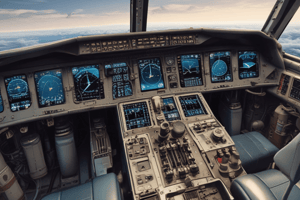Podcast
Questions and Answers
What is the primary function of a three-axis autopilot system?
What is the primary function of a three-axis autopilot system?
- To control altitude and heading simultaneously
- To navigate through GPS and route following
- To control pitch, roll, and yaw simultaneously (correct)
- To provide CRM principles for the crew
What human-centered design principle is responsible for ensuring comfort and accessibility in the cockpit?
What human-centered design principle is responsible for ensuring comfort and accessibility in the cockpit?
- Ergonomics (correct)
- Visibility
- Usability
- Crew Resource Management
What instrument is used to measure the aircraft's speed relative to the speed of sound?
What instrument is used to measure the aircraft's speed relative to the speed of sound?
- Machmeter (correct)
- Turn coordinator
- Airspeed indicator
- Vertical speed indicator
What is the primary function of an altimeter?
What is the primary function of an altimeter?
What is the purpose of a horizontal situation indicator (HSI)?
What is the purpose of a horizontal situation indicator (HSI)?
What is the primary function of a single-axis autopilot system?
What is the primary function of a single-axis autopilot system?
Flashcards are hidden until you start studying
Study Notes
Autopilot Systems
- Definition: Automatic flight control system that uses sensors and computers to control the aircraft's flight trajectory
- Types:
- Single-axis autopilot: Controls one axis of the aircraft (e.g., altitude)
- Two-axis autopilot: Controls two axes (e.g., altitude and heading)
- Three-axis autopilot: Controls all three axes (pitch, roll, and yaw)
- Functions:
- Altitude hold
- Heading hold
- Navigation (e.g., GPS, route following)
- Autoland (automatic landing)
Cockpit Design
- Human-centered design principles:
- Ergonomics (comfort, accessibility)
- Visibility (instrument placement, minimal distractions)
- Usability (intuitive controls, minimal complexity)
- Key components:
- Flight deck (cockpit layout, instrument panel)
- Pilot interface (displays, controls, and alerts)
- Crew resource management (CRM) principles
Flight Instruments
- Primary flight instruments:
- Airspeed indicator
- Altimeter
- Heading indicator (compass)
- Turn coordinator (bank and turn rate)
- Navigation instruments:
- Horizontal situation indicator (HSI)
- Navigation computer
- GPS navigation
- Engine instruments:
- Engine speed indicator (RPM)
- Fuel flow indicator
- Oil pressure and temperature indicators
- Additional instruments:
- Vertical speed indicator (VSI)
- Machmeter (aircraft speed relative to the speed of sound)
Autopilot Systems
- Automatically control the aircraft's flight trajectory using sensors and computers
- Three types of autopilot systems:
- Single-axis: controls one axis of the aircraft (e.g., altitude)
- Two-axis: controls two axes (e.g., altitude and heading)
- Three-axis: controls all three axes (pitch, roll, and yaw)
- Primary functions:
- Maintain altitude
- Hold heading
- Navigate through GPS and route following
- Autoland (automatic landing)
Cockpit Design
- Human-centered design principles ensure:
- Ergonomic comfort and accessibility
- Optimal visibility with minimal distractions
- Intuitive controls with minimal complexity
- Key components of the cockpit:
- Flight deck layout and instrument panel
- Pilot interface (displays, controls, and alerts)
- Crew resource management (CRM) principles
Flight Instruments
- Primary flight instruments:
- Measure airspeed
- Indicate altitude
- Show heading direction
- Display bank and turn rate
- Navigation instruments:
- Horizontal situation indicator (HSI)
- Navigation computer
- GPS navigation
- Engine instruments:
- Monitor engine speed (RPM)
- Measure fuel flow
- Track oil pressure and temperature
- Additional instruments:
- Measure vertical speed
- Indicate Mach number (aircraft speed relative to the speed of sound)
Studying That Suits You
Use AI to generate personalized quizzes and flashcards to suit your learning preferences.




